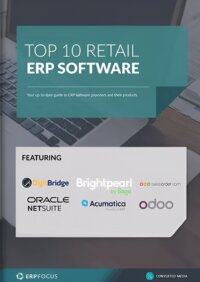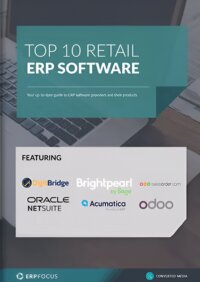Nine signs you need an eCommerce ERP integration
An eCommerce ERP integration coordinates the flow of information between your eCommerce storefront and ERP system in both directions, ensuring data only needs to be entered once.
Connecting your online store with your ERP creates a single source of truth for orders, customers, products, and financials.
By consolidating and streamlining business information in this way, you’ll minimize human error and save time that can be invested in improving merchandising, strengthening your brand, refining the customer experience, expanding to more channels, and supporting long-term growth.
But how do you know when your business needs (and is ready) for integration?
1. You’re selling on multiple sales channels
Growing an online business is tough enough. Adding more channels makes operations significantly more complex.
If you're running Magento, Shopify, an eBay store, and physical retail stores... You're probably used to switching between disparate systems.
All that switching slows your team and increases the likelihood of human error. Without an ERP-integrated eCommerce setup to consolidate orders, inventory, customer data, and accounting, you’ll eventually feel the strain.
2. You’re logging into multiple systems to update orders and customer communications
Even if you only sell on one channel, you may still find yourself juggling several disconnected tools. Think about it.
You need to fulfill and ship orders, update accounting, maintain customer records, and send branded communications. Manually keeping these systems in sync drains time and creates avoidable inconsistencies.
An eCommerce ERP that sits at the center of your workflow eliminates repeat data entry and keeps your team aligned.
3. Your customers are seeing inventory errors
Regardless of how many channels you use, inventory mistakes frustrate customers and create negative reviews, with research from Brightpearl finding that 77% of 1-3 star reviews relate to post-purchase issues.
An ERP-integrated ecommerce workflow reduces these risks by syncing stock levels in real time, supporting barcode scanning in the warehouse, and automating order routing across locations..
4. Your customers are chasing their orders
Your eCommerce platform can handle basic communications, but exceptions require visibility.
Was an order flagged as fraudulent?
Did a supplier short-ship a purchase order?
Will a late cutoff delay dispatch?
When your systems are integrated, your team can quickly identify exceptions and send proactive updates, individually or in bulk, before customers need to ask.
5. You can’t update customers when they do chase
What’s worse than a customer asking about an order? Not being able to find it. Multichannel merchants depend on quick, flexible search.
A connected ERP gives customer service teams instant access using names, emails, order numbers, or shipping details.
6. Your processing costs are skyrocketing
One of the core retail KPIs to track is Processing Cost Per Order. If it costs more to ship an order than the order brings in, you have a structural problem.
A well-organized warehouse helps, but a connected ERP reduces processing costs by automating routine tasks, simplifying pick-pack-ship workflows, and eliminating inefficiencies caused by disconnected systems.
7. Your perfect order rate has hit rock bottom
Your Perfect Order Rate measures on-time shipping, accuracy, and low returns. Without the right systems to track orders and inventory, this number declines.
eCommerce-ERP integration improves accuracy at every step (inventory, fulfillment, purchasing, and customer communication), allowing your team to maintain consistently reliable operations.
8. You’ve had to hire a team of people to manage your sales channels
You need people in the warehouse, but you shouldn’t need extra headcount simply to re-enter data or reconcile one system against another.
ERP-integrated eCommerce platforms automate repetitive tasks so your team can spend time on higher-value activities like marketing, operations planning, and customer experience.
9. You’re fearful of the holiday season every year
At Brightpearl, we hear from businesses regularly who are genuinely fearful of the holiday season because they don’t have adequate processes or systems in place to handle a large surge of orders.
This results in overselling, stressed-out staff, and disappointed customers. Instead, with an eCommerce ERP, you’ll be able to update inventory and accounting in real time across tens of thousands of orders per hour, so that you and your team can focus on physically getting orders out of the door in time for Christmas.
Next steps
If any of the above situations sound familiar, you’re likely ready to move toward eCommerce ERP integration, or to strengthen what you already have.
- Decide on what type of ERP integration you need: Do you sell across multiple channels? Need EDI for major suppliers? Manage several warehouses? Sell both online and in-store? Offer Buy Online, Pick Up In Store? Clarifying these details helps you determine whether you need a native ERP-integrated solution, a middleware-based connector, or a platform-specific integration, such as Shopify or Magento ERP integration. Create an RFP that outlines all must-have and nice-to-have features before speaking to ERP vendors.
- Search the ERP Focus database to find suitable solutions: Now the fun can begin; evaluating providers to see how they do against your RFP. ERP Focus have made it easy for you with their vendor directory, or you can check out these reports for the top ERP systems, or use the free comparison matrix to shortlist ERPs specifically for retail businesses.
- Make a shortlist and choose the right vendor: For most merchants, ERP selection is a task undertaken perhaps once every five years. It may even be the first time you’re doing it. So it’s okay if you’re not totally familiar with everything yet. The first thing to remember is that you need to ask the right questions to ensure the vendor you choose is a risk-free, future-proof, and scalable solution. Check out this ERP selection survival guide or request Brightpearl’s selection criteria checklist; both of which are designed to help you with your decision.
Free white paper

Top 10 Retail ERP Software Comparison
Get your free comparison of the top 10 retail ERPs

Related articles
-

Top 10 ERP selection criteria (including checklist)
The most important ERP selection criteria you should keep in mind during your selection process.
-

CMMC Compliance: What Aerospace and Defense Manufacturers Need to Know
Key insights on CMMC compliance, deadlines, and securing DoD contracts with CMMC 2.0 certificatio...
-
![3 Tips for Achieving Buy-In for Your ERP Integration [by pressfoto on Freepik] 3 Tips for Achieving Buy-In for Your ERP Integration [by pressfoto on Freepik]](/pictures/W1siZiIsIjIwMjQvMTAvMjkvNnQyNmRwdzdwYl8zX1RpcHNfZm9yX0FjaGlldmluZ19CdXlfSW5fZm9yX1lvdXJfRVJQX0ludGVncmF0aW9uX2J5X3ByZXNzZm90b19vbl9GcmVlcGlrXy5qcGciXSxbInAiLCJ0aHVtYiIsIjQwMHgyNjYjIl0sWyJwIiwiZW5jb2RlIiwianBnIiwiLXF1YWxpdHkgODUiXV0/3%20Tips%20for%20Achieving%20Buy-In%20for%20Your%20ERP%20Integration%20%5Bby%20pressfoto%20on%20Freepik%5D.jpg?sha=0e1a55a6cfcac344)
3 tips for achieving buy-in for your ERP integration
Read our expert’s tips on getting your ERP integration project off the ground by achieving busine...

